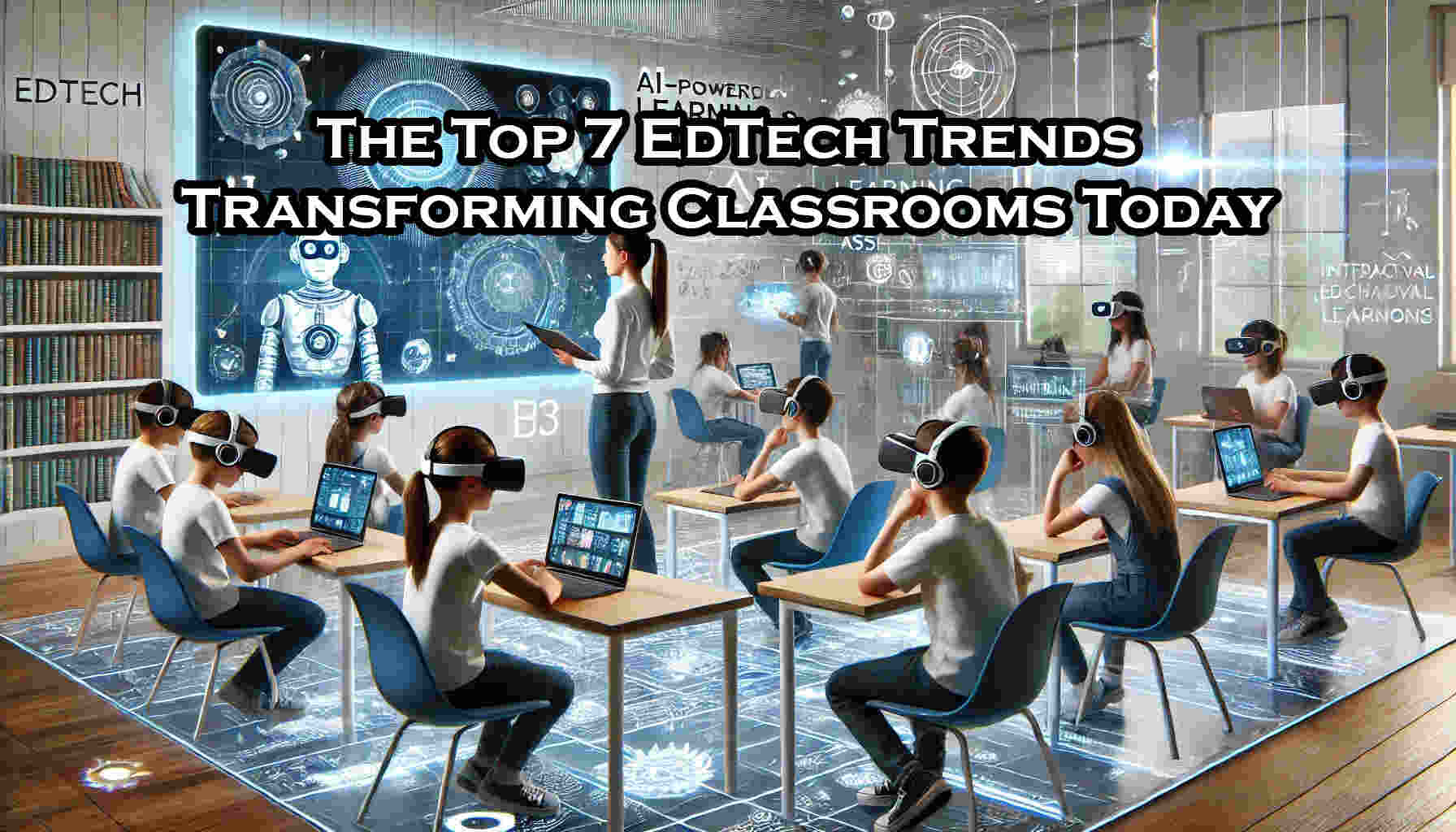Technology is revolutionizing education, creating more engaging, inclusive, and personalized learning experiences. From AI-driven tutoring to immersive virtual reality simulations, classrooms today are evolving faster than ever. Here are the top seven EdTech trends shaping the future of education.
1. Artificial Intelligence (AI) & Personalized Learning
▶Artificial Intelligence is reshaping education by making learning more tailored to individual students. AI-powered platforms analyze students’ performance, identify their strengths and weaknesses, and adapt lesson plans accordingly.
🤖 Adaptive Learning Platforms use AI to provide personalized lesson plans, ensuring students learn at their own pace.
🤖 AI Chatbots & Virtual Tutors offer instant support, answering questions and assisting with homework.
🤖 Automated Grading & Feedback helps teachers save time by assessing assignments and providing immediate feedback.
▶As AI advances, classrooms will become even more responsive to the unique needs of every learner.
2. Gamification & Game-Based Learning
▶Gamification makes learning more interactive by incorporating elements like rewards, competition, and challenges to boost motivation. Game-based learning takes this further by integrating video games into lesson plans to teach concepts in an engaging way.
🤖 Gamified Learning Apps like Kahoot! and Duolingo use points, leaderboards, and badges to make education fun.
🤖 Educational Video Games immerse students in problem-solving experiences, from historical quests to coding puzzles.
🤖 Escape Room & Puzzle-Based Learning challenges students to solve academic problems collaboratively.
▶By making education more enjoyable, gamification keeps students engaged and motivated.
3. Augmented Reality (AR) & Virtual Reality (VR)
▶AR and VR create immersive learning experiences, transporting students beyond textbooks and classrooms into interactive digital environments.
🤖 Virtual Field Trips allow students to explore historical landmarks, space, or even inside the human body.
🤖 AR-Enhanced Textbooks bring learning materials to life with 3D models and interactive overlays.
🤖 Virtual Labs & Simulations enable students to conduct science experiments and practice technical skills safely.
▶These technologies make abstract concepts tangible, improving comprehension and retention.
4. Online & Hybrid Learning
▶With the rise of digital tools, students can now access education from anywhere, leading to the popularity of online and hybrid learning models.
🤖 Learning Management Systems (LMS) like Google Classroom and Moodle help teachers organize courses, assign tasks, and track progress.
🤖 Video Conferencing & Virtual Classrooms allow remote students to participate in real-time discussions.
🤖 Asynchronous Learning lets students complete coursework at their own pace, offering flexibility.
▶This shift makes education more accessible, accommodating diverse learning styles and schedules.
5. EdTech for Inclusivity & Accessibility
▶Technology is bridging the gap for students with disabilities by providing tools that cater to different learning needs.
🤖 Text-to-Speech & Speech-to-Text Tools help students with reading and writing challenges.
🤖 AI-Powered Transcription & Captioning support deaf and hard-of-hearing students.
🤖 Customizable Digital Learning Materials allow students to adjust font sizes, colors, and formats for better readability.
▶EdTech ensures that all students, regardless of their abilities, can participate fully in learning.
6. Blockchain for Secure Academic Records
▶Blockchain technology is being used in education to securely store and verify academic credentials, making student records tamper-proof and easily shareable.
🤖 Digital Diplomas & Certificates allow graduates to share verified credentials with employers.
🤖 Transparent Attendance & Performance Tracking ensures accuracy in student records.
🤖 Fraud Prevention helps combat fake degrees and credential forgery.
▶Blockchain simplifies verification processes, saving time and ensuring credibility in academic achievements.
7. STEM & Robotics Education
▶With the growing demand for technology skills, STEM (Science, Technology, Engineering, and Math) education is more important than ever. Robotics and coding programs give students hands-on experience in problem-solving and critical thinking.
🤖 Robotics Kits like LEGO Mindstorms and Arduino introduce students to engineering concepts.
🤖 Coding Platforms such as Scratch and Python-based programs teach programming skills from an early age.
🤖 STEM Challenges & Hackathons encourage innovation and creativity.
▶By integrating STEM and robotics into curricula, schools are preparing students for future careers in technology-driven industries.
Final Thoughts
EdTech is not just about modernizing education—it’s about making learning more engaging, inclusive, and effective. As technology continues to evolve, classrooms will become even more dynamic, offering students opportunities to learn in ways that were once unimaginable.
